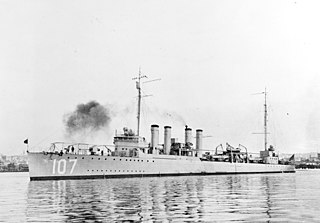
USS Murray (DD-97) was a Wickes-class destroyer built for the United States Navy during World War I.

USS Dyer (DD-84) was a Wickes-class destroyer built for the United States Navy during World War I.

USS McKee (DD-87) was a Wickes-class destroyer built for the United States Navy during World War I.

USS Bell (DD-95) was a Wickes-class destroyer built for the United States Navy during World War I.

USS Mugford (DD-105) was a Wickes-class destroyer built for the United States Navy during World War I.

USS Hazelwood (DD-107) was a Wickes-class destroyer built for the United States Navy during World War I.

USS Champlin (DD-104) was a Wickes-class destroyer built for the United States Navy during World War I.

USS Hart (DD-110) was a Wickes-class destroyer built for the United States Navy during World War I.

USS Ingraham (DD-111) was a Wickes-class destroyer built for the United States Navy during World War I.

USS Ludlow (DD-112) was a Wickes-class destroyer built for the United States Navy during World War I.

USS DeLong (DD-129) was a Wickes-class destroyer built for the United States Navy during World War I.

USS Meredith (DD-165) was a Wickes-class destroyer built for the United States Navy during World War I. She was the first destroyer in the United States Navy that named for a marine.

USS Bush (DD-166) was a Wickes-class destroyer built for the United States Navy during World War I.

USS Burns (DD-171) was a Wickes-class destroyer built for the United States Navy during World War I.

USS Anthony (DD-172) was a Wickes-class destroyer built for the United States Navy during World War I.

USS Sproston (DD-173) was a Wickes-class destroyer built for the United States Navy during World War I.

USS O'Bannon (DD-177) was a Wickes-class destroyer built for the United States Navy during World War I.

USS Morris (DD-271) was a Clemson-class destroyer built for the United States Navy during World War I.

USS McCawley (DD-276) was a Clemson-class destroyer built for the United States Navy during World War I. She was armed with 4 × 4 inch and 2 × 1 pounder guns. She was commissioned on 22 September 1919, served with the Pacific Fleet for 3 years and was laid up on 7 June 1922. McCawley was recommissioned on 27 September 1923, again serving in the Pacific, and decommissioned in 1930 before being sold for scrap.

USS Lamson (DD-328) was a Clemson-class destroyer built for the United States Navy during World War I.




















